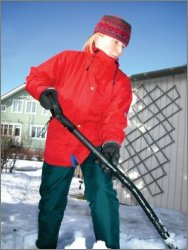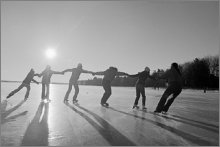What NOT to do for Cold Hands and Seven Other Winter Tips
by www.SixWise.com
Winter brings with it a unique set of temptations and hazards
that exist only at this time of year: frigid temperatures,
ice, snow, and the ever-present allure of outdoor sports like
ice skating and sledding.
|

Shoveling snow can lead to back strain, falls and heart
attacks if not done safely.
|
Not to mention, about 5,800 people suffered from back injuries
in 2007 that were directly related to holiday decorating,
according to the Centers for Disease Control and Prevention.
But just because the holidays are over does not mean you're
out of the woods yet. In all more than 50,000 Americans wind
up with winter-related back injuries, and countless others
suffer from other various winter accidents.
What can you do to stay accident-free this winter season?
Follow these seven winter safety tips.
1. Shovel Snow With Care ...
Injuries from snow removal are some of the most common winter-related
injuries that send people to the emergency room. There's the
risk of back strain, slips
and falls, and even a heart attack from overexertion.
To shovel snow safely:
-
Use a good shovel
-
Keep your back straight and push the snow, rather than
lifting it
-
Pace yourself to avoid overexertion
If you're using a snowblower, use a wooden handle from a
broom or a stick to clear out a jam -- do not reach your hand
into the shoot.
2. Get in Shape Before Trying Out Winter Sports
If you're out of shape, you're at a greater risk of getting
injured while participating in winter sports. Here's what
to get in shape BEFORE you hit the slopes (or ice-skating
pond):
-
For downhill skiing, strengthen the muscles in your upper
leg, quadriceps, and hamstrings
-
For ice-skating, strengthen your ankles, quads and hamstrings
along with your calves and muscles in the front of your
legs.
-
In general, you should get used to aerobic activity that
will strengthen your heart.
3. Stay Warm
Hypothermia and frostbite can occur quickly and without warning
when you're outdoors during the winter. Be sure you dress
in layers and wear a warm hat, scarf, socks and mittens.
According to the American Academy of Pediatrics (AAP), "Clothing
for children should consist of thermal long johns, turtlenecks,
one or two shirts, pants, sweater, coat, warm socks, boots,
gloves or mittens, and a hat. The rule of thumb for older
babies and young children is to dress them in one more layer
of clothing than an adult would wear in the same conditions."
|

Remember to drink plenty of water during outdoor activities
to prevent getting dehydrated.
|
4. If You Get Frostbite ...
Frostbitten skin will be pale, cold and have no feeling,
and later will change to red and painful before the final
stages of white, numb skin when the tissue actually begins
to freeze. If you suspect you have frostbite, you should move
to a warmer place, remove any jewelry or wet clothing, wrap
the area in sterile dressings (separate fingers and toes)
and get to an emergency room immediately.
If medical attention is not immediately available, you should
follow these steps:
-
Immerse the frostbitten area in warm (NOT hot) water,
or apply warm clothes, for 20-30 minutes. This may cause
pain, swelling and color changes, and the process is complete
when the skin is soft and has regained feeling.
-
Do NOT rub or massage the frostbitten areas.
-
Apply sterile dressings to the areas, separating fingers
and toes.
-
Keep the areas as still as possible, and keep them warm
to prevent re-freezing. If you cannot keep the areas from
re-freezing, it may be better to delay the initial warming
process until a safe location can be reached, as re-freezing
can case even more severe tissue damage than the initial
frostbite.
-
Give the person warm drinks to replace any lost fluids.
5. Stay Hydrated
You can get dehydrated
in the winter without even realizing it. Be sure to drink
plenty of water during sports or other strenuous activities,
like snow shoveling.
6. Wear a Helmet ...
This tip is for kids, and applies during a host of winter
sports such as sledding, skiing, snowboarding, tobogganing
and ice hockey.
7. Know How to Walk on Slippery Surfaces
It's best to avoid sidewalks and stairways that you know
are icy, but when it can't be avoided, here's how to minimize
your risk of falling:
-
Take short, shuffling steps
-
Walk slowly and flat-footed
-
Bend your knees slightly and stay flexible (not tense)
in case you do fall
Recommended Reading
How
to Winterize Your Car ... and Your Brain for Winter Driving
12
Tips to Lower Your Heating Bill This Winter
Sources
NYDailyNews.com
December 21, 2007
American
Academy of Pediatrics